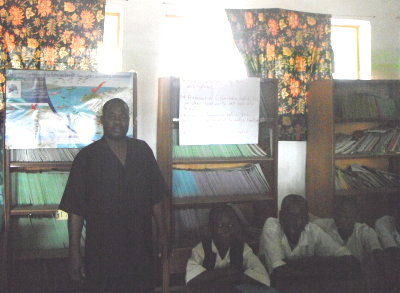Reviewing the first experiences

Stock taking of the first experiences with the use of the teaching kits took place in two workshops organised by Aliou Sall with all teachers.
The workshop in Hann, Senegal, took place 19-20 May gathering two teachers each from:
- the primary school Kayar 1,
- the mid-level school (CEM) in Kayar,
- the Khadim School, the primary school Montagne 1
- and the mid-level school (CEM)
The latter three in Hann.
The review workshop in Gambia took place in Serrekunda, 26-27 May 2012 with two school inspectors and two teachers from each school in attendance. They were from:
- Gunjur Lower Basic School,
- Gunjur Upper Basic School,
- Immaculate Lower Basic School Gunjur,
- Tanji Lower Basic School, and
- Serrekunda Lower Basic School respectively.
 In intensive discussions throughout the weekends the teachers went systematically through their experience in class and during excursions, discussing the teaching aids one by one. With small variations, the assessment converged considerably between the participants of the pilot activities. In summary, the teachers found that
In intensive discussions throughout the weekends the teachers went systematically through their experience in class and during excursions, discussing the teaching aids one by one. With small variations, the assessment converged considerably between the participants of the pilot activities. In summary, the teachers found that
- The guidance paper on methods and approaches was judged useful in structure in that it presented an explanation and background information to each of the five key principles of the ecosystem approach to fisheries followed by proposals for exercises in class and out of class. However, the teachers suggested to simplify the explanatory part and reduce the number of images, particularly those of a more conceptual nature.
- The poster of the EAF Nansen Project depicting two situations, an undesirable fisheries with destructive gear leading to social decline on the coast and an acceptable one showing prosperous coastal landscapes was unanimously accepted as a useful visual aid on a permanent basis.
- The fish rulers have been used to great effect triggering surprises and lots of fresh thinking among the pupils and the fish mongers at the landing sites or markets, however, as already signalled in the start up workshop, outline images should be replaced by full colour pictures to facilitate identification of the species. Scientific names were not deemed necessary for the final version of the fish rulers (see the test version for Senegal to the left).
- The teachers recommended to discontinue the use of the fish can poster - a variation on the fish ruler using a soda can for size comparison in case the more expensive fish rulers were unavailable. They argued that this would implicitly promote the use of unsustainable soft drink cans and thus risk to inadvertendly send the wrong message.
- The poster showing the key components of the Senegambian ecosystem was not sufficiently understood and requires a little more explanation. Rendering the fish species used on the fish ruler more visible in the final version will help increase the integration of the different teaching aids and strengthen mutually reinforcing use. It is also planned to extend that poster to a representation - before-after overfishing - so as to convey the degradation effect on the ecosystem more intuitively. The key message here needs to be that a well structured and functioning marine ecosystem is like a bank account. Most of the resource needs to stay in the sea to produce a steady high 'interest'.
Story telling and imaginary drawings have been used to good effect in application of the guidance notes. The teachers regretted, however, not to have had sufficient time to go deeper in exploring the use of the materials. In particular, several scripts for theatre and role plays had been developed but were not yet finalised, given the limited time slots available for carrying forward this extra-work. The general level of acceptance of the overall approach was high and the teachers engaged in detailed planning how to distribute suitable elements of the teaching messages and approaches across the syllabus in view of continuing the experience into 2013.
They unanimously requested to continue the collaboration and also work towards some additional equipment to bridge the digital divide and enhance the teaching environment for better learning outcomes for the kids.








